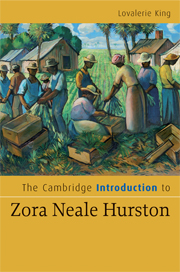4 - Critical reception
Published online by Cambridge University Press: 05 June 2012
Summary
This chapter provides an overview of how Hurston's work has been read and understood both during her life and since her literary resurrection in the 1970s. Zora Neale Hurston's somewhat mixed and often negative early critical reception has been a recurring issue in scholarship about her life and work. Critical reception of literary work is influenced by a number of variables, including the author's purpose for writing, target audience demographics, publishing industry guidelines, the prevailing socio-political order, the prevailing ideology or ideologies, plus internal modes of production that affect mediation – the manner in which the narrative is transmitted to the reader. Add to these variables the fact that Hurston, like other writers associated with the New Negro Movement, relied heavily on patronage that typically came with its own set of conditions. Finally, mainstream American literary criticism took little sustained notice of African American literature prior to the 1970s. Robert Hemenway's Zora Neale Hurston: A Literary Biography (1977), Valerie Boyd's Wrapped in Rainbows: The Life of Zora Neale Hurston (2003), and particularly M. Genevieve West's Zora Neale Hurston and American Literary Culture (2005), all allocate substantial space to examining contexts for contemporaneous criticism of Hurston's work, which helps in understanding some of the reasons that the author died in obscurity and why a literary resurrection was necessary. Still, one must not discount the writer's own personality and how she engages with, and responds to, each of the variables mentioned above.
- Type
- Chapter
- Information
- The Cambridge Introduction to Zora Neale Hurston , pp. 105 - 125Publisher: Cambridge University PressPrint publication year: 2008

